Imperial Qing Monochromes from The J. M. Hu Collection
The Master of Zande Lou
The collection of J.M. Hu represents a lifetime’s dedication to connoisseurship and beauty. Across more than half a century, J.M. Hu acquired an exceptional grouping of Chinese ceramics—and in particular imperial porcelain—that illuminated the rich history of China and its people. In both his personal collection and in his bequests to cultural institutions, J.M. Hu stood as a model of the modern scholar-collector.
Hu Hui Chun was born in 1911 in Beijing; in later years, he changed his given name to Jen Mou. The eldest son of the influential banker Hu Chun, J.M. Hu was raised in an elegant private residence amongst his many stepbrothers and stepsisters. In keeping with tradition, he was given a rigorous background in the Chinese classics; more unusually, this was supplemented by a Western-style education, as well. He first encountered Chinese ceramics during his student years, when he purchased a nineteenth-century brush-washer for his desk. This initial foray into collecting would become emblematic of J.M. Hu’s poignant relationship with art: even amidst the upheavals of war and the evolution of his collection, the modest brush-washer stayed with him until his death in 1995. J.M. Hu’s boyhood studies within the Chinese literati tradition greatly informed his philosophical approach to life and collecting: humble and erudite, he consistently affirmed that it was the visceral connection between a collector and his acquisitions that was of essential importance. True value, in J.M. Hu’s estimation, lay far beyond monetary worth.
Mr. and Mrs. J.M. Hu, mid 1950s.
The early twentieth century was a ‘golden age’ of Chinese collecting. With the fall of the Qing dynasty, numerous works of art became available for the first time, allowing both Chinese and international enthusiasts to assemble world-class private collections. Expanded foreign access to China fostered interest in the nation’s rich history and culture, with ambitious overseas collectors such as John D. Rockefeller, Jr., John Pierpont Morgan, and Sir Percival David acquiring rare Chinese works of art. As the Chinese art market matured, J.M. Hu contended with a growing number of buyers for prized works, aided in his quest by a personal reputation for integrity and connoisseurship amongst Chinese dealers.
As the acquisition of Chinese works of art became increasingly competitive, J.M. Hu chose to concentrate his energies on Ming and Qing imperial porcelains. Qing monochromes, in particular, forever captured his attention. He was a fastidious buyer known for choosing only those pieces in pristine condition; on one occasion, he even rejected a pair of Guyuexuan enameled vases because one of the works had a minute chip in its glaze. A noted traditionalist, J.M. Hu went to great lengths designing wooden stands and fitted boxes to preserve and display his Chinese treasures, and delighted in sharing the collection with fellow connoisseurs. For J.M. Hu, collecting was a serious, scholarly pursuit not to be taken lightly; the joy of art came with a responsibility to honour both the artist and object.
J.M. Hu often spoke of the three necessary criteria in collecting: zhen (authenticity), jing (rarity and quality), and xin (condition). Yet it was an individual’s bond with a work of art—evidenced in J.M. Hu’s beloved brush-washer—that was of fundamental significance. In handling and examining his ceramics, J.M. Hu sought that indefinable delight that could come only from the beauty of artistry. In the tradition of Chinese literati who bestowed symbolic monikers upon their studios, libraries, and collections, the name of J.M. Hu’s studio—Zande Lou—referenced the influential Lanting Xu of the famed Jin dynasty calligrapher Wang Xizhi. The Lanting Xu text describes Zande as a person’s inner happiness. Although J.M. Hu intended the meaning of Zande to express this fleeting happiness—which he experienced as a collector when examining an object—the word has also come to be interpreted as the inherently transitory nature of collecting and possessing fine art.
Mr. J. M. Hu with his collection, 1960s
J.M. Hu’s collection of Chinese ceramics provided abundant opportunity for personal scholarship and historical investigation. As early as the 1940s, he longed for a welcoming social environment where like-minded collectors could share and discuss art and objects. Two decades later, he established the Min Chiu Society in Hong Kong alongside fellow collectors K.P. Chen and J.S. Lee. A noted cultural philanthropist, J.M. Hu gifted substantial groupings from his collection to the Shanghai Museum in 1950 and 1989; many of these objects remain on view in the museum’s Zande Lou Gallery. The collector also arranged to have his family’s set of imperial zitan furniture sent to the National Palace Museum in Taipei for display, and returned the important Siming version of the Huashan Temple stele rubbing to the Palace Museum, Beijing.
J.M. Hu remains a celebrated figure amongst collectors of Chinese art. The remarkable shapes and glazes of the Qing monochromes offered here serve as a reminder of the true spirit of Zande, as J.M. Hu’s beloved ceramics now bestow inner happiness on a new generation of connoisseurs.
Helen D. Ling and Edward T. Chow, Collection of Chinese Ceramics from the Pavilion of Ephemeral Attainment, vol. III (cover).
Helen D. Ling and Edward T. Chow, Collection of Chinese Ceramics from the Pavilion of Ephemeral Attainment, vol. IV (cover).
Lot 2851. A fine pair of Guan-type glazed octagonal vases, Qianlong six-character seal marks in underglaze blue and of the period (1736-1795); 5 5/8 in. (14.3 cm.) high. Estimate HKD 1,000,000 - HKD 1,500,000. Price realised HKD 1,625,000. © Christie's Images Ltd 2017
Each facetted vase is applied to the shoulder with a pair of lug-shaped handles, covered overall with a thick, even glaze of greyish-blue tone, the foot dressed brown, box.
Provenance: The J.M. Hu Collection.
Literature: Helen D. Ling and Edward T. Chow, Collection of Chinese Ceramics from the Pavilion of Ephemeral Attainment, vol. III, Hong Kong, 1950, pl. 167
Lot 2851, illustrated in Collection of Chinese Ceramics from the Pavilion of Ephemeral Attainment, vol. III, pl. 167.
Exhibited: Shanghai Museum, Beijing Museum, Art Museum, The Chinese University of Hong Kong, Qing Imperial Monochromes. The Zande Lou Collection, Shanghai, Beijing, Hong Kong, 2005, Catalogue, pl. 32.
Note: Vases of this type from the Qianlong period were applied with both guan-type and Ru-type glazes. The National Palace Museum Collection has two such examples, each inscribed on the base with an Imperial poem by the Qianlong Emperor, with lines indicating that these vases functioned as receptacles for flowers (see Obtaining Refined Enjoyment: The Qianlong Emperor’s Taste in Ceramics, Taipei, 2012, pl. 85, 86.) The current vases are covered with a thick, greyish-blue glaze and dressed brown on the feet, in imitation of Song guan wares. In the thirteenth year of the Yongzheng reign (1735), the Superintendent of the Imperial kilns at Jingdezhen,Tang Ying, listed in Taocheng jishi bei ji (Commemorative Stele on Ceramic Production), a number of glazes in imitation of Song wares, including ‘moon-white, pale green and deep green, all copied from ancient pieces sent from the Imperial Palace’.
Compare also to a smaller example of this type (13.9 cm.) in the National Palace Museum collection, illustrated in the Catalogue of a Special Exhibition of Qing Monochromes, Taipei, 1981, p. 149, no. 89.
Lot 2852. A rare Guan-type glazed pear-shaped vase, Qianlong six-character seal mark in underglaze blue and of the period (1736-1795); 8 3/4 in. (22.2 cm.) high. Estimate HKD 2,000,000 - HKD 3,000,000. Price realised HKD 7,900,000. © Christie's Images Ltd 2017
The vase is finely potted with a compressed globular body standing on a short splayed foot rising to a long straight neck, applied with an even glaze of sky-blue tone, the foot dressed brown, box.
Provenance: The J.M. Hu Collection.
Literature: Helen D. Ling and Edward T. Chow, Collection of Chinese Ceramics from the Pavilion of Ephemeral Attainment, vol. III, Hong Kong, 1950, pl. 171
Lot 2852, illustrated in Collection of Chinese Ceramics from the Pavilion of Ephemeral Attainment, vol. IV, pl. 171.
Exhibited: Shanghai Museum, Beijing Museum, Art Museum, The Chinese University of Hong Kong, Qing Imperial Monochromes. The Zande Lou Collection, Shanghai, Beijing, Hong Kong, 2005, Catalogue, pl. 33.
Note: The Emperors Yongzheng and Qianlong were keen antiquarians who collected and studied material from earlier dynasties. Deliberate copies of Song crackled glazes were therefore developed at the Qing imperial kilns in response to the emperors’ admiration for these early wares. It was recorded that the Yongzheng Emperor had specifically required good copies of Song glazes to be produced at Jingdezhen, at which the famous kiln director Tang Ying excelled. Tang Ying, in his Taocheng jishi bei ji (Commemorative Stele on Ceramic Production), listed out a number of glazes in imitation of Song wares, including ‘moon-white, pale green and deep green, all copied from ancient pieces sent from the Imperial Palace’.
Compare to a larger crackled Ru-type glazed vase (26.8 cm) of similar shape from the Nanjing Museum, illustrated in Treasures in the Royalty: The Official Kiln Porcelain of the Chinese Qing Dynasty, Shanghai, 2003, p. 332. Compare also to a smaller Ru-type crackled glazed vase (17.2 cm) of similar form but with a gently flared mouth from the Stephen Junkunc, III Collection, sold at Christie’s New York, 19 March 2008, lot 658.
Lot 2853. A fine and rare Guan-type glazed gu-shaped vase, Qianlong six-character seal mark in underglaze blue and of the period (1736-1795); 7 7/8 in. (20.2 cm.) high. Estimate HKD 2,000,000 - HKD 3,000,000. Price realised HKD 3,940,000. © Christie's Images Ltd 2017
The vase is finely potted with a compressed globular mid-section above a spreading foot and below a widely flared neck, the mid and lower-sections each with four vertical flanges, covered overall with a lustrous glaze of pale greyish-blue tone, the foot dressed brown, box.
Provenance: The J.M. Hu Collection.
Literature: Helen D. Ling and Edward T. Chow, Collection of Chinese Ceramics from the Pavilion of Ephemeral Attainment, vol. III, Hong Kong, 1950, pl. 173
Lot 2853, illustrated in Collection of Chinese Ceramics from the Pavilion of Ephemeral Attainment, vol. IV, pl. 173.
Exhibited: Shanghai Museum, Beijing Museum, Art Museum, The Chinese University of Hong Kong, Qing Imperial Monochromes. The Zande Lou Collection, Shanghai, Beijing, Hong Kong, 2005, Catalogue, pl. 36.
Note: The form of the present vase is based on the bronze ritual wine vessels known as gu from the Shang and Zhou dynasties, which were adapted as vases in later periods. This form provided inspiration for the guan and ge wares from the Song dynasty, notable for their pale greyish-blue colour and distinctive crackle, often finished on the foot with a brown dressing. The popularity of this form persisted throughout the later Ming and Qing dynasties. The present vase is an example that reflects this rich history, in its conscious imitation of earlier forms and glazes during the Qianlong reign.
According to the Comprehensive Records of Zaobanchu Workshops, the Emperor ordered wood stands to be made for seven pieces of ceramics in the second year of the Qianlong reign; one of which was a guan-type glazed gu-shaped vase with flanges. Additionally, in the third year of the Qianlong reign, Tang Ying was ordered by the Emperor to fire additional vases based on a Ru-type glazed flanged gu, with drawings prepared by draftsmen in the Imperial Household Workshops. The Qianlong Emperor was particularly interested in antiquities and reviving the traditions of the past. By these means he intended both to consolidate the position of the Manchu-born Qing empire within the long dynastic history of China, and to restore what he regarded as the superior moral rectitude of ancient times.
Compare to a pair of Ru-type glazed gu-shaped vases with slightly more pronounced flanges, also from the Zande Lou Collection, sold at Sotheby’s Hong Kong, 9 October 2012, lot 108, and illustrated in the Qing Imperial Monochromes – The Zande Lou Collection, Hong Kong, 2005, p. 86, no. 26. Also, compare to a slightly larger Qianlong marked guan-type glazed vase of similar form (26.8 cm high) in the Nanjing Museum, illustrated in the Qing Imperial Porcelain of the Kangxi, Yongzheng and Qianlong Reigns, Hong Kong, 1995, no. 32.
Lot 2854. A very rare Ru-type glazed gu-shaped vase, Qianlong six-character seal mark in underglaze blue and of the period (1736-1795); 8 1/8 in. (20.6 cm.) high. Estimate HKD 2,400,000 - HKD 3,200,000. Price realised HKD 3,460,000. © Christie's Images Ltd 2017
The vase is potted with a spreading foot rising to a globular mid-section and trumpet neck, with two raised bands above and below the midsection, glazed overall in pale sky-blue, the foot dressed brown, box.
Provenance: The J.M. Hu Collection.
Literature: Helen D. Ling and Edward T. Chow, Collection of Chinese Ceramics from the Pavilion of Ephemeral Attainment, vol. III, Hong Kong, 1950, pl. 171.
Lot 2854, illustrated in Collection of Chinese Ceramics from the Pavilion of Ephemeral Attainment, vol. III, pl. 170.
Exhibited: Shanghai Museum, Beijing Museum, Art Museum, The Chinese University of Hong Kong, Qing Imperial Monochromes. The Zande Lou Collection, Shanghai, Beijing, Hong Kong, 2005, Catalogue, pl. 33.
Note: The form of the present vase is based on the bronze ritual wine vessels known as gu from the Shang and Zhou periods, such as the example illustrated in the woodblock printed catalogue Xiqing Gujian, ‘Inspection of Antiques’, which was published under the auspices of the Qianlong Emperor (fig. 1). The form enjoyed further popularity as the inspiration for Song-dynasty imperial wares, including ceramics covered with guan and ge glazes. The lustrous, uncrackled greyish-blue glaze on the current vase harks back to the revered Ru wares from the Northern Song dynasty. The present vase reflects this rich history, in its conscious imitation of earlier forms and glazes.
fig. 1.
It appears that the Qianlong Emperor enjoyed vases made in this classical gu shape. According to the Comprehensive Records of Zaobanchu Workshops, in the second year of the Qianlong reign, the Emperor ordered the Superintendent of the Imperial kilns at Jingdezhen, Tang Ying, to fire tianbai vases based on the shape of the classical gu vessels, with drawings prepared by draftsmen in the Imperial Household Workshops. Later in the third year of the Qianlong reign, a Ru gu-shaped vase was sent over to Jingdezhen for the potters there to replicate. It is very likely that the current vase is one of these examples specifically commissioned by the Qianlong Emperor.
Vases of similar shape and design were also fired in the Kangxi reign. Compare, for example, to a sky-blue glazed and a white-glazed gu-shaped vases, both with Kangxi reign marks and similarly decorated above and below the bulging mid-section with raised bands, but with additional friezes of bosses, in the Palace Museum, illustrated in Monochrome Porcelain, The Complete Collection of Treasures of the Palace Museum, Hong Kong, 1999, pls. 90 and 112.
Lot 2855. A fine Guan-type glazed vase, Qianlong six-character seal mark in underglaze blue and of the period (1736-1795); 7 7/8 in. (20 cm.) high. Estimate HKD 1,600,000 - HKD 2,400,000. Price realised HKD 4,900,000. © Christie's Images Ltd 2017
The vase is potted with a compressed globular body above a short splayed foot and below a long slender neck rising to a slightly flared mouth, covered overall with a crackled glaze of greyish-green tone. The foot is applied with a brown dressing, box.
Provenance: The J.M. Hu Collection.
Literature: Helen D. Ling and Edward T. Chow, Collection of Chinese Ceramics from the Pavilion of Ephemeral Attainment, vol. III, Hong Kong, 1950, pl. 172.
Lot 2855, illustrated in Collection of Chinese Ceramics from the Pavilion of Ephemeral Attainment, vol. IV, pl. 172.
Exhibited: Shanghai Museum, Beijing Museum, Art Museum, The Chinese University of Hong Kong, Qing Imperial Monochromes. The Zande Lou Collection, Shanghai, Beijing, Hong Kong, 2005, Catalogue, pl. 34.
Note: The characteristics of Song guan wares, with a brown dressed foot and glaze thinning at the mouth rim to reveal the body underneath, is well exemplified on this current vase. Compare to another Qianlong-marked vase of this shape, with a ge-type glaze, sold at Sotheby’s Hong Kong, 20 May 1986, lot 83. A guan-type glazed vase with a Yongzheng mark of similar form was sold at Christie’s Hong Kong, 27 May 2009, lot 1888.
Lot 2856. A fine and very rare peacock-feather glazed garlic-head vase, Yongzheng incised four character seal mark and of the period (1723-1735); 10 7/16 in. (26.2 cm.) high. Estimate HKD 6,500,000 - HKD 7,500,000. Price realised HKD 12,700,000. © Christie's Images Ltd 2017
The vase is superbly potted with a pear-shaped body below a raised rib at the shoulder, rising to a slender neck and bulb-shaped mouth, covered overall with a thick bright turquoise glaze suffused with marbled mottling of deep red and violet tone. The foot ring is applied with a dark brown dressing, box.
Provenance: The J.M. Hu Collection.
Literature: Helen D. Ling and Edward T. Chow, Collection of Chinese Ceramics from the Pavilion of Ephemeral Attainment, vol. III, Hong Kong, 1950, pl. 139.
Lot 2856, illustrated in Collection of Chinese Ceramics from the Pavilion of Ephemeral Attainment, vol. III, pl. 139.
Exhibited: Shanghai Museum, Beijing Museum, Art Museum, The Chinese University of Hong Kong, Qing Imperial Monochromes. The Zande Lou Collection, Shanghai, Beijing, Hong Kong, 2005, Catalogue, pl. 20.
Note: The extraordinary effect of this glaze is achieved by applying an opaque stippled turquoise glaze coloured with copper and made opaque by mixing the arsenic as an opacifier. Rose Kerr noted in Chinese Ceramics, Porcelain of the Qing dynasty, London, 1986, p. 88, that while visual examination reveals there to be two distinctive types of robin’s-egg glaze, one streaked with copper-red and the other stippled with blotches of turquoise and dark blue, further analysis is required to clarify the chemistry of these glazes. The Robin’s-egg glaze was a monochrome glaze first invented in the Yongzheng reign. The peacock-feather glaze appears to be closely related to the more common robin’s-egg glaze, but the former is much rarer, possibly due to the difficulty in successfully achieving its desired effect.
The form of this vase is based on the bronze wenhu (flask warmer) from the Han Dynasty, such as the example illustrated in the woodblock printed catalogue Xiqing Gujian, ‘Inspection of Antiques’, which was published under the auspices of the Qianlong Emperor (fig. 1). An almost identical vase, also incised with a Yongzheng four-character mark, is in the National Palace Museum, illustrated in Catalogue of a Special Exhibition of Qing Monochromes, Taipei, 1981, pl. 41 (fig. 2). The same collection has another larger vase of similar form but of different proportions (47.1 cm.), incised with a Qianlong reign mark (acquisition no. zhong-ci-0003849). Compare also to a peacock-feather glazed censer, incised with a Yongzheng six-character seal mark, sold at Christie’s Hong Kong, May 31 2010, lot 1883.
fig. 1.
fig. 2. A peacock-feather glazed garlic-head vase, Yongzheng mark and period (1723-1735), Collection of the National Palace Museum, Taipei.
Lot 2857. A fine and rare white-glazed anhua-decorated ‘kui dragon’ vase, Yongzheng six-character mark in underglaze blue within a double circle and of the period (1723-1735); 4 7/8 in. (12.3 cm.) high. Estimate HKD 800,000 - HKD 1,200,000. Price realised HKD 2,125,000. © Christie's Images Ltd 2017
The tiered vase is delicately potted with two raised bands dividing the body into three registers. The neck is incised with a band of upright lappets, the shoulder with kui dragons, the central frieze with stylised ruyi pattern, and the foot with archaistic motifs. The vessel is covered overall with a clear glaze, box.
Provenance: The J.M. Hu Collection.
Literature: Helen D. Ling and Edward T. Chow, Collection of Chinese Ceramics from the Pavilion of Ephemeral Attainment, vol. III, Hong Kong, 1950, pl. 128.
Lot 2857, illustrated in Collection of Chinese Ceramics from the Pavilion of Ephemeral Attainment, vol. III, pl. 128.
Exhibited: Shanghai Museum, Beijing Museum, Art Museum, The Chinese University of Hong Kong, Qing Imperial Monochromes. The Zande Lou Collection, Shanghai, Beijing, Hong Kong, 2005, Catalogue, pl. 23.
Note: The current vase, with its highly unusual form, is based on guan tiered vases from the Song and Yuan dynasties, such as a three-tiered celadon guan square vase in the National Palace Museum Collection, dating to the Southern Song to Yuan dynasty, illustrated in Precious as the Morning Star: 12th-14th Century Celadons in the Qing Court Collection, Taipei, 2016, p. 166-167, no. 11-48. Two other three-tiered celadon guan vases of similar form in the same collection are illustrated in Catalogue of the Special Exhibition of Sung Dynasty Kuan Ware, Taipei, 1989, P. 49, no. 3-4.
It is also likely that the current vase, applied with an even, lustrous clear glaze revealing the fine white body underneath, was intended to imitate the ivory-white Ding wares from the Song dynasty. Multiple entries from the Comprehensive Records of Zaobanchu Workshops documented that the Yongzheng Emperor had repeatedly ordered special stands to be made for selected Ding pieces in the Imperial collection, or have draftsmen make drawings of them. Additionally, the Records indicated that in the seventh year of his reign, a white Ding vase was sent to the Imperial kilns at Jingdezhen and the Emperor requested vases covered in guan-type and other glazes to be produced using it as a model. This reflected the Yongzheng Emperor’s deep interest in Ding white wares. The current vase, with its glaze resembling that of Ding wares and form resembling that of guan wares, superbly exemplifies the Emperor’s archaistic taste and pursuit.
An identical white-glazed anhua-decorated ‘kui dragon’ vase is in the National Palace Museum (acquisition no. zhong-ci 000759) (fig. 1). There is also another type of Yongzheng white-glazed vase of the same form and design, but with decorative motifs moulded in relief, such as the example fitted with a cover, in the Beijing Palace Museum Collection, illustrated in Qingdai yuyao ciqi, juan 1, xia, Beijing, 2005, pl. 87, and another example without a cover, in the National Place Museum (acquisition no. zhong-ci 000753).
fig. 1. A white-glazed anhua-decorated ‘kui dragon’ vase, Yongzheng mark and period (1723-1735), Collection of the National Palace Museum, Taipei.
Lot 2858. A fine and rare white-glazed rectangular handled vase, Yongzheng period (1723-1735); 4 3/8 in. (11 cm.) wide. Estimate HKD 320,000 - HKD 480,000. Price realised HKD 1,500,000. © Christie's Images Ltd 2017
The vase is potted with a rectangular foot and body below an angular flaring neck rising to a mouth of conforming shape. The neck is decorated with a raised band. The stepped shoulder is applied with a pair of scroll-shaped handles. The vessel is covered overall with an even clear glaze with the exception of the foot; box.
Provenance: The J.M. Hu Collection.
Literature: Helen D. Ling and Edward T. Chow, Collection of Chinese Ceramics from the Pavilion of Ephemeral Attainment, vol. III, Hong Kong, 1950, pl. 129.
Lot 2858, illustrated in Collection of Chinese Ceramics from the Pavilion of Ephemeral Attainment, vol. III, pl. 129
Exhibited: Shanghai Museum, Beijing Museum, Art Museum, The Chinese University of Hong Kong, Qing Imperial Monochromes. The Zande Lou Collection, Shanghai, Beijing, Hong Kong, 2005, Catalogue, pl. 24.
Note: The form of this vase, which almost resembles a compressed gu-shaped vessel and probably based on a metalwork shape, is extremely rare. No other identical example appears to have been published to date.
Christie's. Imperial Qing Monochromes from The J. M. Hu Collection, 29 November 2017, Hong Kong

/https%3A%2F%2Fprofilepics.canalblog.com%2Fprofilepics%2F1%2F0%2F100183.jpg)
/https%3A%2F%2Fstorage.canalblog.com%2F03%2F02%2F119589%2F96711876_o.jpg)
/https%3A%2F%2Fstorage.canalblog.com%2F11%2F31%2F119589%2F94773502_o.jpg)
/https%3A%2F%2Fstorage.canalblog.com%2F20%2F83%2F119589%2F94772815_o.jpg)
/https%3A%2F%2Fstorage.canalblog.com%2F26%2F72%2F119589%2F75604929_o.jpg)
/https%3A%2F%2Fstorage.canalblog.com%2F59%2F60%2F119589%2F26458628_o.jpg)












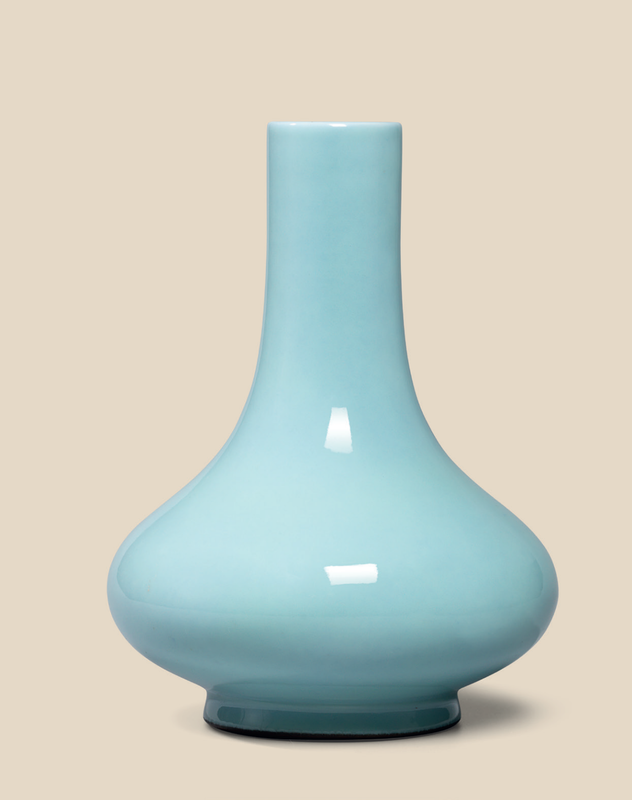


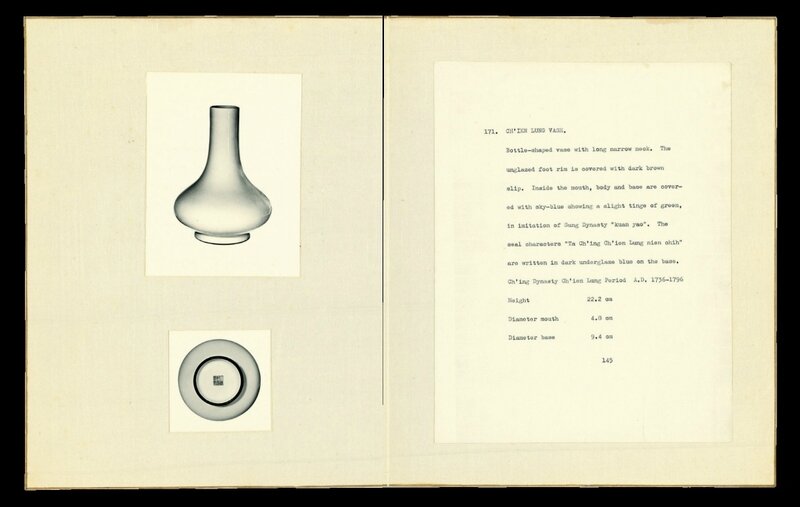





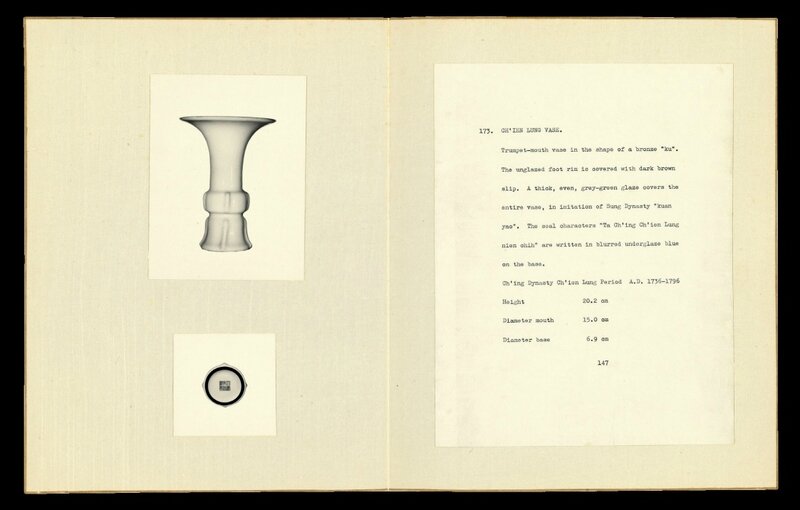







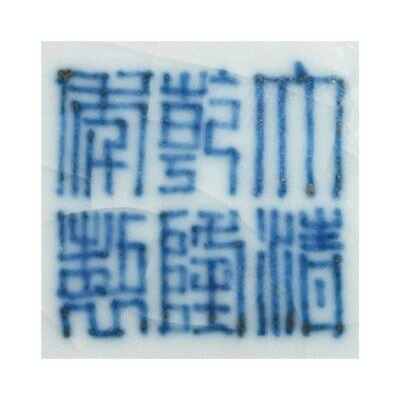













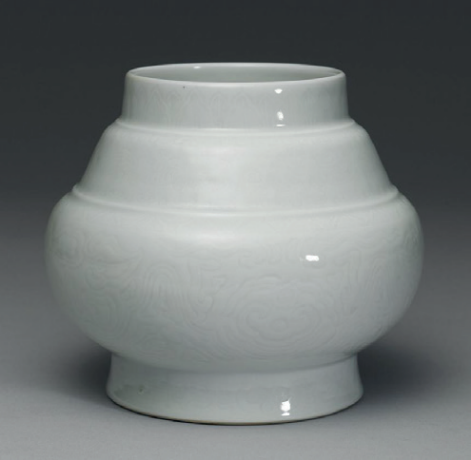






/http%3A%2F%2Fstorage.canalblog.com%2F72%2F98%2F119589%2F126496130_o.jpg)
/http%3A%2F%2Fstorage.canalblog.com%2F03%2F01%2F119589%2F126394237_o.jpg)
/http%3A%2F%2Fstorage.canalblog.com%2F94%2F75%2F119589%2F126394170_o.jpg)
/http%3A%2F%2Fstorage.canalblog.com%2F60%2F76%2F119589%2F126370763.jpg)